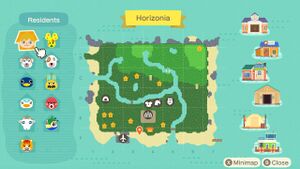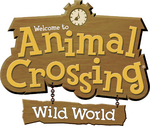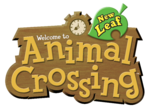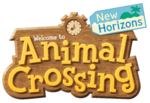Town
The town or village (island in New Horizons) is the primary setting of all main games in the Animal Crossing series, home to villagers of various species, and special characters who manage the town's facilities. Each town is randomly generated and populated at the beginning of each game when the first player moves to the town. Although the position of many structures are fixed, the town can be customized to a great degree by planting or removing flora, placing designs, placing furniture, (in New Horizons) and constructing objects and public works projects (in Doubutsu no Mori e+ and New Leaf respectively). Every town is divided into multiple acres, the landscape of which must be carefully maintained in order to achieve a perfect town environment rating.
Prior to New Horizons, the first player to start the game is given the task of naming the town, which cannot be changed after creation unless they rebuild the town. Up to three additional players can move into town, with a maximum capacity of four player residents. The maximum number of villagers that can live in a single town varies between the games: 15 in Animal Crossing, 8 in Wild World, and 10 in City Folk and New Leaf.
In New Horizons, the player doesn't start in a town, instead traveling to a deserted island. It fulfills many of the same roles as the town in other games, being home to the player and their neighbors. However, the game starts with only two NPC villagers, who are also new to the island. The number of player residents that can coexist in the island has increased from four to eight, each one corresponding to each Nintendo Switch user account. The maximum number of villagers that can live on the island is 10, much like in City Folk and New Leaf.
Common town features[edit]
- Player houses
- Each player has their own personal house within the town, which can be furnished to their desire. Houses are regularly inspected by the Happy Home Academy, who award points based on the contents and upkeep of the home. The player must choose where they wish to live at the beginning of the game. Houses can be expanded after paying off the loan owed to Tom Nook, which will give the player more space inside to furnish their home.
- In Animal Crossing, all four player houses are located in a single plaza in acre B-3, and any unoccupied houses remain vacant until a new player character is created. Wild World only features a single house which all players must share. Each player once again has their own house in City Folk, all of which are positioned randomly throughout the town. In New Leaf, the player is able to select a location for their house, but it will not be constructed until they pay their initial mortgage. In the interim, the player is provided a tent as a temporary home. As a result of this change, vacant houses do not exist in the game. In New Horizons, the player can once again select a location for their house, but will be given a tent until the initial mortgage of 49,800 Bells (5,000 Nook Miles) is paid off. The player may also relocate their house once per day for a fee of 8,000 Bells.
- Villager houses
- Every villager has a residence in the town, and can only be entered by the player when the villager is inside. In Animal Crossing, they can also be entered when the villager is present in the same acre as their house. Each villager's house has pre-determined furnishings, but in games from Wild World onwards the player can influence and alter the contents of the villagers' homes. In most games, villagers will always build their houses on top of signposts, but in New Leaf they can construct their homes almost anywhere in town, including on top of flora and ground designs, and in front of buildings and other structures. When a villager moves out of town, their house will vanish completely. In New Horizons, villagers will always move into open plots, which the player can place where they wish. The Resident Representative can also relocate one villager house per day for a fee of 10,000 Bells.
- Facilities
- A variety of facilities can be found throughout the town, and differ between the games. Such facilities include the dock, the dump, the museum, police station, post office or town hall, and the wishing well or event plaza. Shops can also be found within the town, such as Tom Nook's store, The Able Sisters, and Re-Tail. The locations of facilities will appear only in certain acre rows in Animal Crossing, but in later games, they can be situated almost anywhere in town. In City Folk and New Leaf, many facilities are instead located in the city and Main Street, respectively. In New Horizons, the museum and Nook's Cranny will first be given tents which the player can place anywhere on the island they can access, which will upgrade to buildings once certain conditions are met. The Able Sisters will be constructed once the player has spent enough Bells when Mabel visits.
- The train station is the first port of call within the town in Animal Crossing and New Leaf, and where the player arrives at the beginning of the game. Players can take the train to visit other towns, and receive other players who arrive on incoming trains. The station is absent in Wild World and City Folk, having been replaced with the checkpoint which functions in much a similar manner. The Airport fulfills these functions in New Horizons, along with some of the functions provided by the post office in previous games.
- In every game except for Wild World, the town is divided into upper and lower levels, separated by cliffs. In Animal Crossing, it is possible to have two rows of cliffs, creating a three-tier town. In Animal Crossing: New Leaf, the cliffs simply divide the town from the beach. Access between the different tiers is provided by ramps. Cliffs also surround the edges of every town, except for in New Horizons, and the player cannot access the areas beyond them. In New Horizons, cliffs can be climbed with either the ladder tool or a constructed incline, one layer at a time.
- The town houses a variety of flora; trees, flowers, and in New Leaf and New Horizons, bushes and bamboo can be grown by the player. Flora improves the environment rating of the town, and can attract certain bugs.
- Water
- Every town has a river running through it, which can only be crossed by bridges prior to New Horizons. In New Horizons, a vaulting pole can also be used provided the river isn't too wide, and one-tile or two-tile sections can be jumped over. Waterfalls and a pool can be found along the river's route, before feeding into the sea, though pools do not exist in New Horizons. Each town also contains a small number of holding ponds. In Wild World, City Folk, and New Horizons, it's possible for the river to split into two, creating an islet. This occurrence is fairly common in New Horizons. Fish can be found and caught in all bodies of water, but vary depending on the season.
- Beach
- Situated in the south of town, along with the eastern or western edge in New Leaf, and both the eastern and western edges in New Horizons, the beach separates the land from the sea. Shells, bottle notes, and even castaways will periodically wash ashore. In Animal Crossing: New Leaf, coconuts and bananas can be grown in the sand, but public works projects cannot be placed there. In New Horizons, the beaches have rocks scattered about along them, and a very small beach will also generate on the north side of the island.
- Civic structures
- Doubutsu no Mori e+ allows players to pay Tom Nook to construct decorative objects around the town. The mayor in New Leaf can customize the town by constructing Public Works Projects. In both games, these include a variety of buildings, benches, clocks, lamps, bridges, sculptures, among other options. In New Leaf and New Horizons, Lloid will appear to collect the funds required to erect a public works project or island construction project, and Isabelle assists the mayor with selecting locations for projects in New Leaf. An optional completion ceremony can be held in both games when a project is completed.
Landscape[edit]
The landscape of each town is randomly generated, and therefore it is very unlikely that two towns will be the same.
In Animal Crossing[edit]
The town in Animal Crossing is 30 acres in size; 5 across and 6 down. Acres are more distinct than in later games, as the camera is limited to showing only one acre at a time. The top of the town features railway tracks and the train station. There will also be at least one cliff running approximately horizontally through the town, which the player can climb using ramps. Sometimes, there are two cliffs, creating a three-tier town. Certain structures will always be generated in specific acres or acre rows; the train station, Tom Nook's store and the post office will be in the A-acres. All player houses will always be in acre B-3. The police station, museum, and wishing well will always be in the C, D or E acres, while the Able Sisters and the dock will always be along the beach.
Tortimer will allow for a third bridge to be built when the town reaches the maximum population of 15 villagers, making it easier to cross the river.
In Wild World[edit]
Wild World has the smallest town size, at 16 acres (4x4). Unlike other games, there are no cliffs and the entire town lies on a single plain. Grassy areas are less abundant, giving towns a more desert-like appearance. Tom Nook's store will always be next to the Able Sisters.
The river may branch off in a two-pronged fork, creating an islet in the village. An islet will always have a signpost or villager's house located on it.
In City Folk[edit]
City Folk towns are similar to Animal Crossing ones and are 25 acres (5x5) in size. Cliffs and ramps return, but three-tier towns will never be generated (despite the game having the resources for them) and the Able Sisters is separate from Tom Nook' store once again. If the player donates enough Bells to the Town Fund, additional features such as an extra bridge, a fountain, a windmill or a lighthouse can be built.
The terrain of City Folk towns are inverted to Wild World, in that grass is the dominant terrain. However, grass will deteriorate over time.
In New Leaf[edit]
New Leaf towns consist of 20 acres, however, the beach runs along both the southern end of town and also the eastern or western side. Railway tracks can be found to the north, as well as a crossing that leads to Main Street. The beach has a dock where a boat can be taken to Tortimer Island. Cliffs separate the town and beach. Grass in town will deteriorate, but not as quickly as it does in City Folk.
One significant change from earlier installments is the lack of signposts. Instead, villagers will move in anywhere where there is space, sometimes destroying trees or flowers in the process. At the beginning of the game Rover will display four different maps, allowing the player to select the desired layout for the town.
Every town contains a train station, Re-Tail, and the town hall. The mayor can construct public works projects including clocks, benches, lamps, bridges, and facilities such as The Roost and police station.
In New Horizons[edit]
In New Horizons, the town is initially a deserted island consisting of 42 acres (7x6), making this the largest setting yet in the Animal Crossing series in terms of acres. It is surrounded on three sides with beaches broken up with rocks, and with very large rocks and a tiny section of beach on the north side. The island initially contains only two buildings: the Resident Services tent, located in a random part of the lowest level of town, and the Airport which is always located along the southern shoreline, though its longitude varies. As there are no bridges at first, and rivers do not naturally generate at a width of any lower than three tiles, the rivers on the island cannot be crossed until the player obtains a vaulting pole. As there are no natural inclines, cliffs cannot be ascended without a ladder. At the very beginning of the game, only around 1/3 of the island is accessible to the player as they will not have access to these tools. The island is initially covered with a large amount of weeds, though the player is encouraged to pick them to earn Nook Miles and to help beautify the island. The entire island being a livable area and the lack of a designated area for shopping (such as the city or Main Street) make it more similar to Animal Crossing and Wild World in this manner.
The island features three layers, with the lowest layer being the largest traversible section, the middle and top-most layers are typically much smaller and contain pine trees and flowers. The river's source will always be on the top-most layer, and flow down waterfalls to the lowest layer where it will exit in two directions. The river mouths can either both be on the southern shoreline, or one in the south and the other in the eastern or western shore of the island. Certain fish can only be found in the section of river that flows on the upper two levels of the island. One or more ponds can exist on the lowest layer and generate in a variety of shapes, such as a heart.
The first player to move to the island is the Resident Representative and can later construct additional buildings (the museum, Nook's Cranny, and Able Sisters), bridges and inclines. With the Island Designer Construction Permit, the player is able to modify the terrain at will, creating or destroying water and cliffs. An additional fourth layer can be added to the island, though it is not possible to climb it in any way. Most buildings can be relocated by making a request to Tom Nook and paying a relocation fee, but the locations of the Resident Services and Airport are fixed and these buildings cannot be moved.
Gallery[edit]
A promotional concept image of an Animal Crossing: New Leaf town.
See also[edit]
| Locations | ||||||||||||||||||||||||
|---|---|---|---|---|---|---|---|---|---|---|---|---|---|---|---|---|---|---|---|---|---|---|---|---|
| ||||||||||||||||||||||||
| Animal Crossing: Wild World | ||||||||||||||||||||||
|---|---|---|---|---|---|---|---|---|---|---|---|---|---|---|---|---|---|---|---|---|---|---|
| ||||||||||||||||||||||
| Animal Crossing: City Folk | ||||||||||||||||||||||
|---|---|---|---|---|---|---|---|---|---|---|---|---|---|---|---|---|---|---|---|---|---|---|
| ||||||||||||||||||||||
| Animal Crossing: New Horizons | |||||||||||||||||||||||||||||||
|---|---|---|---|---|---|---|---|---|---|---|---|---|---|---|---|---|---|---|---|---|---|---|---|---|---|---|---|---|---|---|---|
| |||||||||||||||||||||||||||||||
| Gameplay elements | ||||||||||||||||||||||||||
|---|---|---|---|---|---|---|---|---|---|---|---|---|---|---|---|---|---|---|---|---|---|---|---|---|---|---|
| ||||||||||||||||||||||||||






